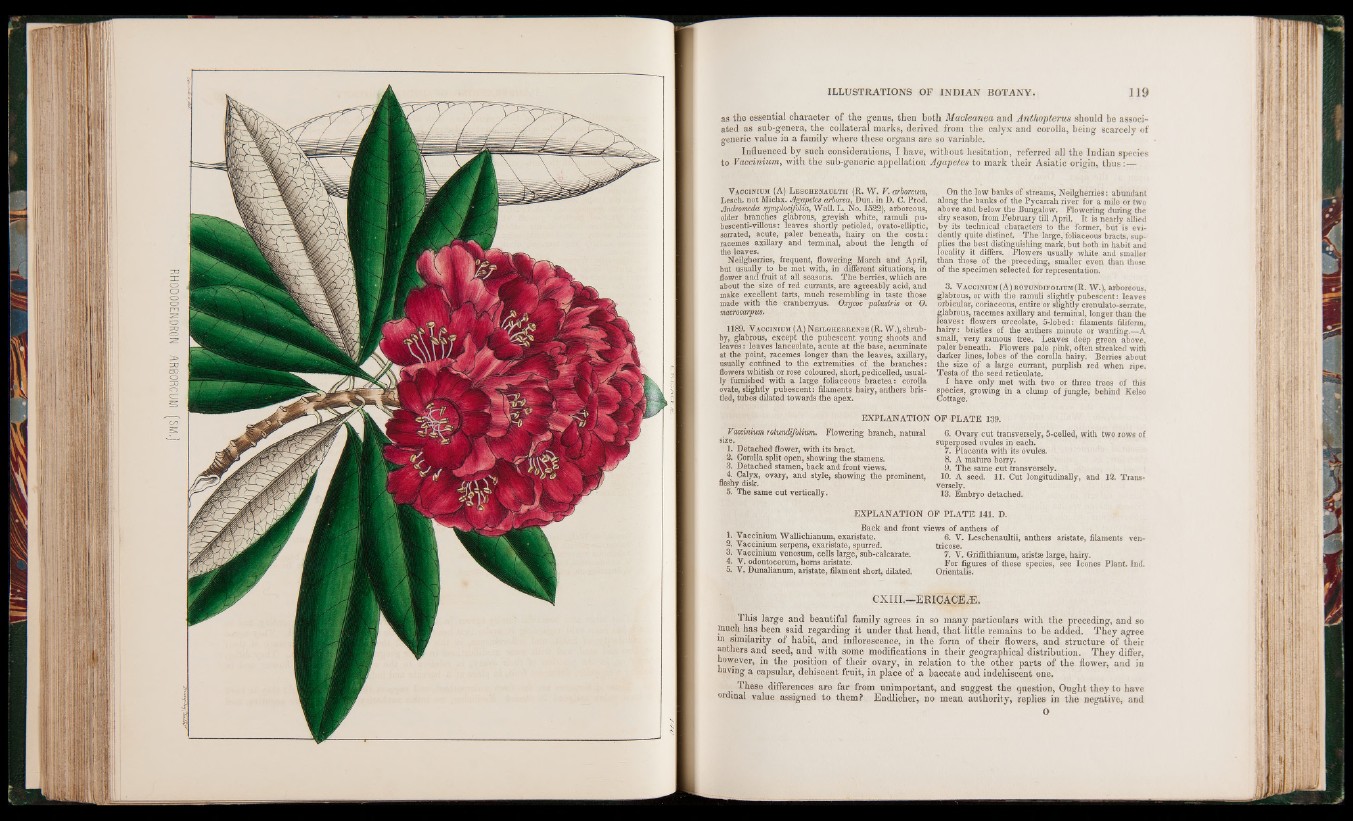
as the essential character of the genus, then both Macleanea and Anthopterus should be associated
as sub-genera, the collateral marks, derived from the calyx and corolla, being scarcely of
generic value in a family where these organs are so variable.
Influenced by such considerations, I have, without hesitation, referred all the Indian species
to Vaccinium, with the sub-generic appellation Agapetes to mark their Asiatic origin, thus:—
Vaccinium (A) Leschenaultii (R. W . V. arboreum,
Lesch. not Michx. Agapetes arborea, Dun. in D. C. Prod.
Andromeda symplodfolia, Wall. L. No. 1522), arboreous,
older branches glabrous, greyish white, ramuli pu-
bescenti-villous: leaves shortly petioled, ovato-elliptic,
serrated, acute, paler beneath, hairy on the costa:
racemes axillary and terminal, about the length of
the leaves.
Neilgherries, frequent, flowering March and April,
but usually to be met with, in different situations, in
flower and fruit at all seasons. The berries, which are
about the size of red currants, are agreeably acid, and
make excellent tarts, much resembling in taste those
made with the cranberryus. Oxycoc palustris or O.
macrocarpus.
1189. Vaccinium (A) Neilgherrense (R. W.), shrubby,
glabrous, except the pubescent young shoots and
leaves: leaves lanceolate, acute at the base, acuminate
at the point, racemes longer than the leaves, axillary,
usually confined to the extremities of the branches:
flowers whitish or rose coloured, short, pedicelled, usually
furnished with a large foliaceous bractea: corolla
ovate, slightly pubescent: filaments hairy, anthers bristled,
tubes dilated towards the apex.
On the low banks of streams, Neilgherries: abundant
along the banks of the Pycarrah river for a mile or two
above and below the Bungalow. Flowering during the
dry season, from February till April. It is nearly allied
by its technical characters to the former, but is evidently
quite distinct. The large, foliaceous bracts, supplies
the best distinguishing mark, but both in habit and
locality it differs. Flowers usually white and smaller
than those of the preceding, smaller even than those
of the specimen selected for representation.
3. Vaccinium (A) rotundifolium (R. W.), arboreous,
glabrous, or with the ramuli slightly pubescent: leaves
orbicular, coriaceous, entire or slightly crenulato-serrate,
glabrous, racemes axillary and terminal, longer than the
leaves: flowers urceolate, 5-lobed: filaments filiform,
hairy : bristles of the anthers minute or wanting.—A
small, very ramous tree. Leaves deep green above,
paler beneath. Flowers pale pink, often streaked with
darker lines, lobes of the corolla hairy. Berries about
the size of a large currant, purplish red when ripe.
Testa of jhe seed reticulate.
I have only met with two or three trees of this
species, growing in a clump of jungle, behind Kelso
Cottage.
EXPLANATION OF PLATE 139.
Vaccinium rotundifolium. Flowering branch, natural
size.
1. Detached flower, with its bract.
2. Corolla split open, showing the stamens.
3. Detached stamen, back and front views.
4. Calyx, ovary, and style, showing the prominent,
fleshy disk.
5. The same cut vertically.
6. Ovary cut transversely, 5-celled, with two rows of
superposed ovules in each.
7. Placenta with its ovules.
8. A mature berry.
9. The same cut transversely.
10. A seed. 11. Cut longitudinally, and 12. Transversely.
13. Embryo detached.
EXPLANATION OF PLATE 141. D.
Back and front views of anthers of
1. Vaccinium Walhchianum, exaristate. 6. V. Leschenaultii, anthers aristate, filaments ven-
2. Vaccinium serpens, exaristate, spurred. tricose.
3. Vaccinium venosum, cells large, sub-calcarate. 7. V. Griffithianum, aristas large, hairy.
4. V. odontocerum, horns aristate. For figures of these species, see leones Plant. Ind.
5. V. Dunalianum, aristate, filament short, dilated. Orientalis.
CXIIL—ERICACÉÆ.
This large and beautiful family agrees in so many particulars with the preceding, and so
much has been said regarding it under that head, that little remains to be added. They agree
m similarity of habit, and inflorescence, in the form of their flowers, and structure of their
anthers and seed, and with some modifications in their geographical distribution. They differ,
however, in the position of their ovary, in relation to the other parts of the flower, and in
having a capsular, dehiscent fruit, in place of a baccate and indéhiscent one.
O